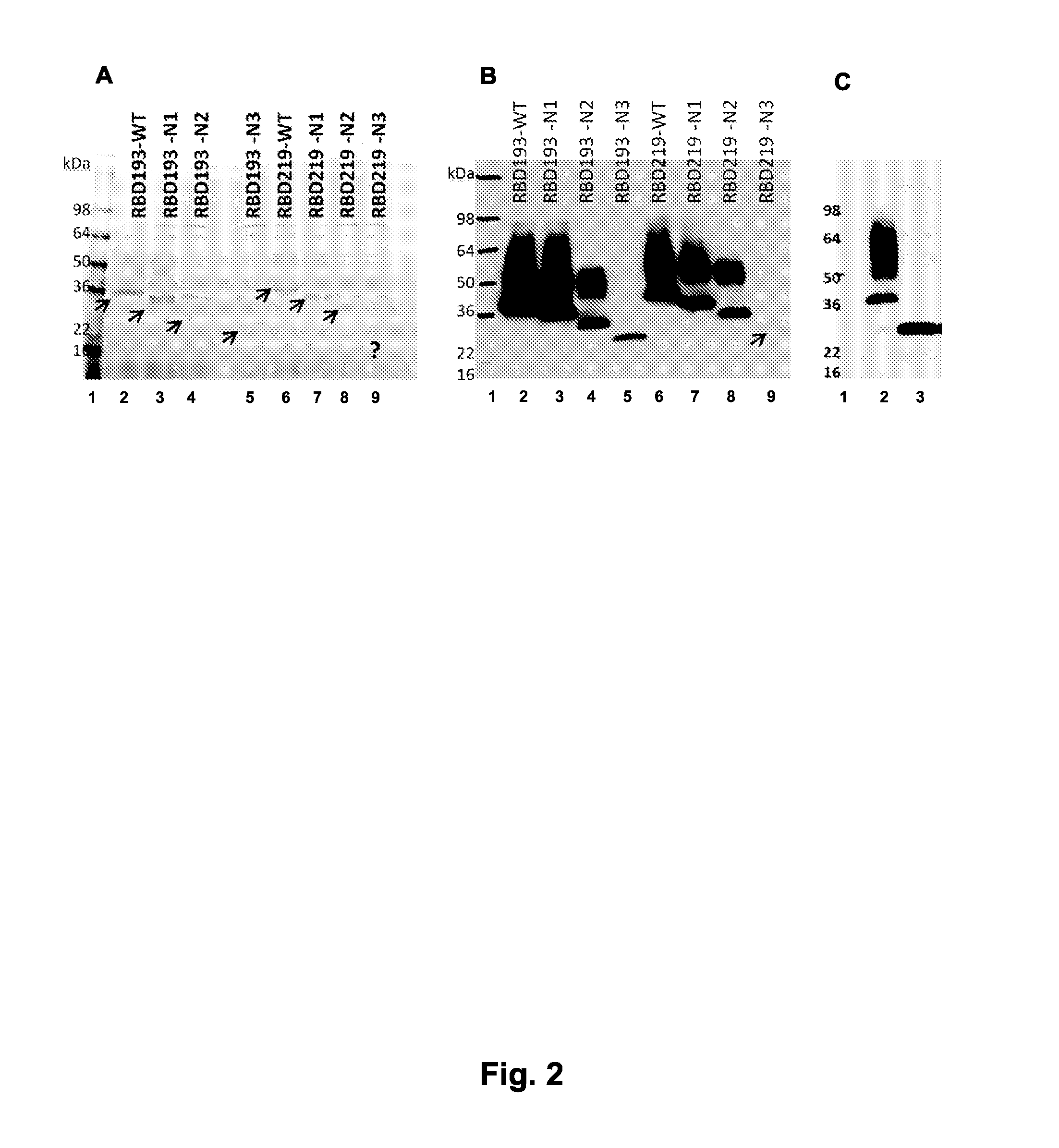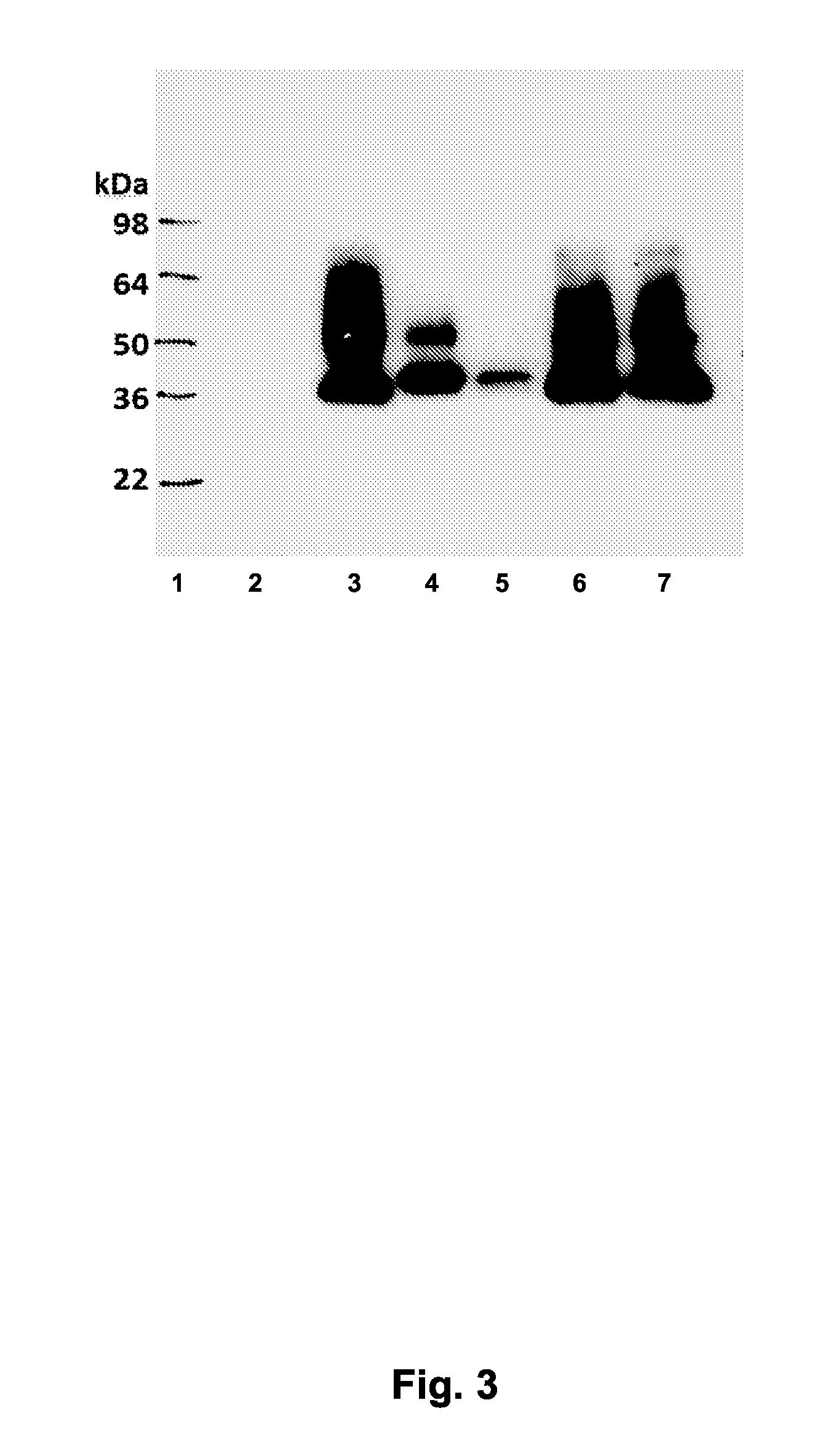A novel sars immunogenic composition
a technology of immunogenic composition and sars, applied in the field of cell biology, molecular biology, immunology, virology, biochemistry, vaccinology, etc., to achieve the effects of preventing or delaying the onset of sars, reducing at least one symptom of sars, and preventing or delaying the onset of mers
- Summary
- Abstract
- Description
- Claims
- Application Information
AI Technical Summary
Benefits of technology
Problems solved by technology
Method used
Image
Examples
example 1
Exemplary Materials and Methods
[0144]Cloning and Expression of RBDs in Yeast Pichia pastoris
[0145]The DNAs encoding the 193-aa (RBD193, residues 318-510) and 219-aa (RBD219, residues 318-536) of SARS-CoV RBD were codon-optimized based on yeast codon usage preference and synthesized by GenScript (Piscataway, N.J.), followed by subcloning into Pichia secretory expression vector pPICZαA (Invitrogen, Grand Island, N.Y.) using EcoRI / XbaI restriction sites. The correct insert sequences and reading frames of recombinant plasmids were confirmed by double-stranded sequencing using vector flanking primers α-factor and 3′AOX-1. The recombinant plasmid DNAs were then transformed into Pichia pastoris X-33 by electroporation. The expressions of recombinant RBD193 and RBD219 were induced with 0.5% methanol at 30° C. for 72 h, and the highest expression clone was chosen to make seed stock in 20% glycerol as described previously (He et al., 2005).
[0146]Because high glycosylation of the RBD193 / RBD21...
example 2
Expression of Recombinant RBDS in P. Pastoris
[0168]Different constructs of RBD193 and RBD219 (WT, N1, N2 and N3) were transformed into P. pastoris X-33, and 20 clones from each transformation were induced for recombinant protein expression in 10 ml tubes with 0.5% methanol. After induction for 72 h, recombinant RBDs with different size for different constructs were observed by SDS-PAGE Coomassie-stained gels and Western blot with anti-RBD mAb 33G4. The apparent molecular weight (M.W.) of recombinant RBDs was higher than expected based on the sequence, and a high M.W. smear was observed, especially in wild-type (WT) constructs, in both RBDI93 and RBD219, indicating that the recombinant RBD-WTs were glycosylated or aggregated (FIGS. 2A and 2B). The extent of glycosylation of RBD193-WT was confirmed by digesting the protein with N-glycosidase PNGase F. After digestion, the high M.W. smear disappeared, and the size of RBD193-WT returned to the expected M.W. (23 kDa) (FIG. 2C). This ass...
example 3
Optimization of Expression Condition
pH and Detergent
[0169]To maximize the expression yield and minimize the possible aggregation of recombinant RBDs in P. pastoris X33, RBDI93-WT was used as the prototype to test the optimized induction conditions using media with different pH and / or different concentration of Empigen detergent. Based on Western blot with anti-RBD mAb 33G4, the optimal pH for RBD193 expression was pH 6.0. No target protein was expressed in culture with pH 5.0, and even less expression of RBD193 was seen in media with pH over 6.0. The addition of (0.01% or 0.05%) Empigen detergent did not improve the expression yield or change the pattern of expressed RBD, indicating that aggregation does not affect expressed RBD193-WT (FIG. 3).
PUM
| Property | Measurement | Unit |
|---|---|---|
| Composition | aaaaa | aaaaa |
| Length | aaaaa | aaaaa |
Abstract
Description
Claims
Application Information
 Login to View More
Login to View More - R&D
- Intellectual Property
- Life Sciences
- Materials
- Tech Scout
- Unparalleled Data Quality
- Higher Quality Content
- 60% Fewer Hallucinations
Browse by: Latest US Patents, China's latest patents, Technical Efficacy Thesaurus, Application Domain, Technology Topic, Popular Technical Reports.
© 2025 PatSnap. All rights reserved.Legal|Privacy policy|Modern Slavery Act Transparency Statement|Sitemap|About US| Contact US: help@patsnap.com



